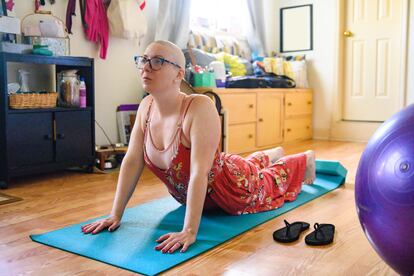How physical exercise is key to the treatment of breast cancer
Working out can reduce the risk of developing the disease, help avoid the side effects of therapy and may also improve prognosis and survival rates

A marathon does not have to be 26 miles: each person has their own. “Exercise during treatment was key to maintaining my mood and some sense of normality. When you go through cancer, your life takes a dramatic turn, one where you can barely control what happens,” says Diana, 42, who was diagnosed with a breast tumor in the middle of the coronavirus pandemic. Her routine changed suddenly: she went from working, climbing and traveling to suffering early menopause, a mastectomy and chemo drips. “In that scenario, doing some physical activity gave me a feeling of being able to do something good for myself, while the chemo did its job,” she explains.
Physical activity, according to research, is an ally in this type of pathology, since it reduces the risk of chronic diseases, the side effects of treatments, and can improve prognosis and survival.
Risk reduction
Although many factors influence the development of cancer, the role of exercise in reducing the risk of developing the disease may work through various biological routes. Ana Lluch, a professor of medicine at the University of Valencia in Spain and head of the Hematology and Oncology Service at Valencia University Clinical Hospital, explains: “We know that physical exercise reduces, for example, the percentage of body fat mass; we know that obesity and being overweight implies higher levels of sex hormones, as well as an increase in pro-inflammatory cytokines, so reducing these levels would prevent a lack of control in the programmed cell death of our body, as well as uncontrolled cell multiplication. Physical exercise, among other effects, also strengthens the immune system, reduces oxidative stress and free radicals.” However, Lluch notes that it is essential not to make categorical statements, since more research is necessary to reinforce the current findings “and to obtain more evidence regarding the amount of physical exercise that would be necessary to obtain a clear reduction in the risk of suffering from cancer.”

The Oncological Physical Exercise Program launched in 2017 by GEICAM, a leading breast cancer research organization in Spain, was created with the aim of developing projects about the benefits of working out as a risk reduction strategy, generating a network of specialists in the field, and discussing its advantages with patients, institutions and the general population. The oncologist explains that 1,017 women recently diagnosed with breast cancer and 1,017 women without the disease participated in the epiGEICAM study about the impact of lifestyles (including physical exercise, the type of diet, and alcohol consumption) in the development of breast cancer in Spain. “We observed that Spanish women with a sedentary lifestyle have a 71% higher risk of developing breast cancer throughout their lives than women who meet international physical exercise recommendations (150 minutes of exercise per week), moderate aerobic physical activity, or 75 minutes of vigorous aerobic physical activity each week, and that 13.8% of new cases could be avoided by performing physical activity,” said Lluch.
A part of the treatment
“When I finished the treatment and the most severe postoperative period, I took up activities as simple as walking. After almost a year, when my oncologist gave me the green light, I started incorporating strength training twice a week, which has been completely key in my recovery,” explains Diana as she leaves the gym. Her workouts are supervised by a professional who adapts the exercise to her needs. She is progressing little by little and can slowly go back to doing everyday things like climbing stairs, carrying her scooter to go to work or going for a walk along nature trails.
Dr. Joaquin Gavilá, head of Clinical Medical Oncology at the Valencia Institute of Oncology Foundation (IVO), also advises patients like Diana to do exercise. “It is part of what we know as a comprehensive approach to breast cancer.”
The World Health Organization (WHO) recommends doing 150 minutes of moderate physical activity per week. “On a physical level, we see a clear example in situations associated with lower bone mineral density, such as osteoporosis caused by systemic treatments, and lytic bone metastases [those that promote bone destruction]. Exercise increases bone mineral density of the lumbar spine and femoral neck in adults and, therefore, can prevent bone fractures and other events associated with the skeleton,” explains Gavilá.
Aerobic vs. strength
Recovering cancer patients face new challenges. “I had a premature menopause and a general change in my body. In this scenario, exercising has helped me not only feel better, but also to reconcile with myself and rebuild myself, to return to the active life that I had always enjoyed,” Diana acknowledges.
Research indicates that, on a physical level, aerobic and strength exercise determine significant changes in body composition by decreasing the percentage of fat, increasing lean mass and causing improvements in strength. “By reducing the percentage of body fat, there is a lower probability of obesity and therefore a lower risk of recurrence. On a psychological and psycho-physical level, it allows a lower perception of pain, especially the shoulder pain that remains after surgery and radiotherapy for breast cancer, improves fatigue, anxiety and depression, as well as quality of life and self-esteem,” Gavilá emphasizes.
Lymphedema
About 30% of patients may develop lymphedema, an abnormal accumulation of lymphatic fluid that results from inadequate lymphatic transport in the operated arm, three years after treatment. Reviews note that strength training appears to be a safe and non-harmful way to reduce lymphedema risk. Gavilá clarifies: “It is usually a general belief that breast cancer patients should avoid upper body exercise, but training with progressive strength exercises does not increase the incidence of lymphedema and, on the contrary, can have favorable effects in patients who are at risk, clearly reducing their signs and symptoms.”
From theory to practice
- The recommendations for cancer patients, from the American College of Sports Medicine (ACSM), are similar to those of the WHO for healthy patients: 30 minutes of brisk walking for five days a week. In this case, to reduce the risk of other diseases, it is also recommended to perform some strength activities combined with aerobic activities. A study showed that women who remained active after diagnosis of breast cancer had a 67% lower risk of relapse and a 45% lower risk of death than those who had an inactive lifestyle. It is important to exercise during treatment, adapting the intensity to the needs of each stage. This will help maintain physical independence and improve the patient’s quality of life. The exercise should be developed by a qualified professional, adapted to each level and based on scientific evidence.
- Ana Lluch, professor of Medicine at the University of Valencia and head of the Hematology and Oncology Service at the University Clinical Hospital of Valencia, says that “it is never too late to start being active. The benefit of physical exercise is also observed in people who have not been active; we found evidence that shows that women who increased their physical activity after menopause may also have a lower risk of breast cancer than those who do not. The free time available today is usually limited, so it is important to find an activity that is entertaining and that creates adherence. We could make a simile with medications, which must be taken from time to time, with a certain dosage and maintained over time for it to have an effect; We have to do physical exercise at least twice a week and maintain this activity regularly to obtain the associated benefits for our health.”
Sign up for our weekly newsletter to get more English-language news coverage from EL PAÍS USA Edition
Tu suscripción se está usando en otro dispositivo
¿Quieres añadir otro usuario a tu suscripción?
Si continúas leyendo en este dispositivo, no se podrá leer en el otro.
FlechaTu suscripción se está usando en otro dispositivo y solo puedes acceder a EL PAÍS desde un dispositivo a la vez.
Si quieres compartir tu cuenta, cambia tu suscripción a la modalidad Premium, así podrás añadir otro usuario. Cada uno accederá con su propia cuenta de email, lo que os permitirá personalizar vuestra experiencia en EL PAÍS.
¿Tienes una suscripción de empresa? Accede aquí para contratar más cuentas.
En el caso de no saber quién está usando tu cuenta, te recomendamos cambiar tu contraseña aquí.
Si decides continuar compartiendo tu cuenta, este mensaje se mostrará en tu dispositivo y en el de la otra persona que está usando tu cuenta de forma indefinida, afectando a tu experiencia de lectura. Puedes consultar aquí los términos y condiciones de la suscripción digital.
More information
Archived In
Últimas noticias
Most viewed
- Reinhard Genzel, Nobel laureate in physics: ‘One-minute videos will never give you the truth’
- Oona Chaplin: ‘I told James Cameron that I was living in a treehouse and starting a permaculture project with a friend’
- Pablo Escobar’s hippos: A serious environmental problem, 40 years on
- Chevy Chase, the beloved comedian who was a monster off camera: ‘Not everyone hated him, just the people who’ve worked with him’
- Why we lost the habit of sleeping in two segments and how that changed our sense of time











































